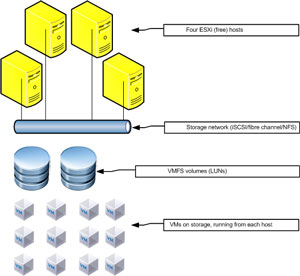Vanover's Virtual Space
Unmanaged ESXi Storage Planning
Considering using the free ESXi? above all else, give some thought to the storage.
- By Rick Vanover
- 04/01/2009
In the current virtualization landscape and the foreseeable future, free offerings continue to make legitimate claims to datacenters of all sizes. I want to focus on the free version of VMware ESXi in particular. ESXi is a strong competitor for the standalone hypervisor, and we can take advantage of one key feature: ESXi supports VMware's virtual machine file system (VMFS), which is the most underrated technology that VMware has produced to date.
By using VMFS with free ESXi installations, we can architect the storage in a similar fashion to what we do with a fully managed host with vCenter. What I am saying is that just because we may be considering using ESXi as unmanaged hosts, we don't have to take a different route with storage provisioning. For administrators who are currently using vCenter, this is a no-brainer. For administrators who are yet get the funding for vCenter licensing and are limited to free ESXi installations only, this is a good architectural step in the right direction.
I'm making one fundamental assumption here: that shared storage is in place. With shared storage, we can overcome the lack of a managed failover that comes with the licensed feature of VMware HA. The shared storage can be fibre channel, iSCSI or NFS on devices that are supported on the VMware hardware compatibility guide. By making the investment in ensuring that shared storage is available to the free ESXi hosts, we can provide an element of redundancy by allowing the other hosts to manually add the VMs to their inventory.

[Click image to view larger
version.] |
| Figure 1. By architecting the storage for the unmanaged hosts to be like that of their fully managed counterparts, the VMs can be easily moved between hosts offline. |
For many smaller organizations, providing shared storage will be a challenge both in cost and administration. If you can make it happen, do it. The shared storage model for virtualization has many benefits as a whole. Inevitably, free ESXi installations will use local disk storage by using the ESXi installable versions. That is where the unmanaged hosts can become trouble from the management side. Many may argue that Citrix XenServer with free live migration and management would be best for most considering the free product space. My preference is for VMware-based virtualization, and the configuration above is a step forward to rolling the free hypervisors into a managed infrastructure. I believe the free edition of ESXi can make a claim in datacenters of all sizes.
Are you embracing this edition to save on licensing costs or to get started with server consolidation? Let me know your approach to provisioning shared storage with the free ESXi, or share your comments below.
About the Author
Rick Vanover (Cisco Champion, Microsoft MVP, VMware vExpert) is based in Columbus, Ohio. Vanover's experience includes systems administration and IT management, with virtualization, cloud and storage technologies being the central theme of his career recently. Follow him on Twitter @RickVanover.